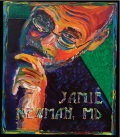A newfangled column
The first stethoscope was created with a rolled-up sheaf of papers in 1816.
In Paris, almost exactly 200 years ago, René-Théophile-Hyacinthe Laënnec was rounding in the hospital. He came to a young woman and was faced with a diagnostic dilemma, which he described in his landmark book, “De l’Auscultation Médiate ou Traité du Diagnostic des Maladies des Poumons et du Coeur”:
Using a quire (a rolled-up sheaf of papers), he created the first stethoscope. The date was Sept. 13, 1816.

Not everyone thought it was a great improvement. Henry Halford, president of the Royal College of Physicians, wrote to Laënnec, “I am sorry to observe that you have much employed yourself with this new-fangled device...which is only suited to midwives and surgeons...”
In modern medicine, we are beset with newfangledness (a term from Late Middle English, newefongel, meaning “to be inclined toward the new”). Ultrasounds, PET scans, tricorders—sometimes it's hard to know which test achieves which purpose. I can remember as an intern asking a cardiology fellow to tell me what he thought of a murmur and being told to get an echo if I wanted to find out.
This is not a new problem. It was best described by the physician/poet Oliver Wendell Holmes (Senior, that is, father of Junior, the Supreme Court Justice) in his 1848 poem, “The Stethoscope Song: A Professional Ballad,” which describes the travails of a young physician who buys a scope in Paris and returns to Boston. Unfortunately, he enters into a series of misdiagnoses courtesy of an arachnid who took up residence in his stethoscope.
The ensnared flies buzzed away, and this sound mimicked that of a murmur to the ears of the young auscultator, with unfortunate consequences for his first patient.
The young physician diagnosed amphoric buzzing and empyema, and the recommended treatment was to plunge a trocar in the patient's side. “They tapped the patient, so he died.”
The next patient was an old lady “long been sick” who was offended by his efforts to “thump her and tumble her ruffles so.” By this Holmes is referring to the art of percussion (invented by the Austrian physician/musician Leopold Auenbrugger), as well as the exposure needed to do the auscultative part of the physical exam. The flies created such a ruckus of buzzing that 3 separate bruits were diagnosed, leading to great interest among physicians in the area in this medical oddity, with an unfortunate outcome. “They every day her ribs did pound, in squad of 20, so she died.”
Things were not going well for this young physician. His last cohort of patients was 6 young women, presumably with pica, as they “loathed their puddings and buttered rolls, and dieted much to their friends' surprise, On pickles and pencils and chalk and coals.” The insect-induced pseudo-rales caused him to miss the diagnosis again, but he did ask his patients for permission to perform a post-mortem when they expired. This led to a remarkable recovery on the patients' part but bad news for the physician's career, as he was then banished from Boston to a practice in a country town (maybe in Minnesota?).
In the poem, a technique is developed to check stethoscopes for flies in advance. And in the last stanza, Holmes gives a timeless piece of advice:
Today we stand 200 years after the invention of the stethoscope, and 150 years or so after this profound warning. We should learn to embrace new technology, but not at the cost of losing our connection to our patients. Relying on a high-tech test result, even if it contradicts our clinical impression, is a major risk.
It's hard to argue with a written report. But nonetheless, in our modern age, Holmes's warning is all the more important as technology rules. Next time you get a PET scan report that doesn't jibe with your clinical suspicion, call the radiologist, and make sure they are not having an insect infestation.



